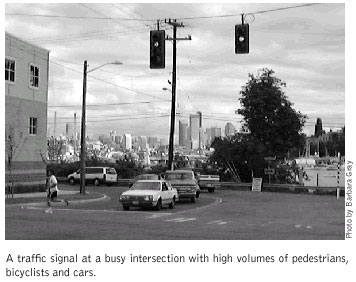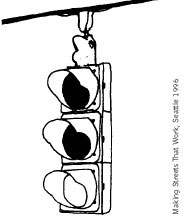40. Traffic Signals
Traffic signals create gaps in traffic flow allowing pedestrians to cross the street. They should allow adequate crossing time for pedestrians and an adequate clearance interval based upon a maximum walking speed of 4 feet per second. A lower speed of less than 4 ft/sec should be used in determining pedestrian clearance time for areas where there is a heavy concentration of elderly or children. Signals are particularly important at high use, mid-block crossings on higher speed roads, multi-lane roads or at highly congested intersections. National warrants from the "Manual on Uniform Traffic Control Devices" based on the numbers of pedestrians and vehicles crossing and intersection are usually used in the selection of traffic signal sites1. However, judgment must also be used on a case-by-case basis. For example, a requirement for installing a traffic signal is that there are a certain number of pedestrians present. If a new facility is being built - a park or recreational path, for example - there will be a new demand, and the signal should be installed in conjunction with the new facility based on projected crossing demand. There may also be latent demand if a destination is not currently accessible but could become so with new facilities or redesign.
In downtown areas signals are often closely spaced, sometimes every block. They are usually spaced further apart in suburban or outlying areas. When high pedestrian traffic exists during a majority of the day, fixed-time signals should be used to consistently allow crossing opportunities. Pedestrian actuation should only be used when pedestrian crossings are intermittent.


Purpose:
- Provides intervals in a traffic system where pedestrians can cross streets safely.
Considerations:
- Where pedestrian traffic is regular and frequent, pedestrian phases should come up automatically. Pedestrian actuation should only be used when pedestrian crossings are intermittent.
- Signal cycles should be kept short (ideally 90 seconds maximum) to reduce pedestrian delay. Pedestrians are very sensitive to delays and a 30 second maximum wait time is ideal.
- Marked crosswalks at signals can encourage pedestrians to cross at the signal and help dissuade motorists from encroaching into the crossing area.
Estimated cost
$30,000–$140,000.